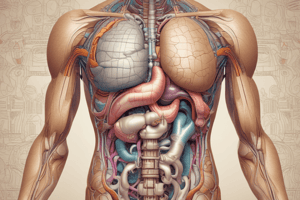Podcast
Questions and Answers
What is the primary function of the pancreas in the digestive system?
What is the primary function of the pancreas in the digestive system?
- Mechanical digestion of food in the mouth
- Producing bile for fat digestion
- Secretion of digestive enzymes to break down carbohydrates, proteins, and fats (correct)
- Storage of food in the digestive system
What is the process by which the body breaks down ammonia into urea?
What is the process by which the body breaks down ammonia into urea?
- Glomerular filtration
- Deamination (correct)
- Selective reabsorption
- Tubular secretion
What is the name of the small, finger-like projections in the small intestine that increase the surface area for absorption of nutrients?
What is the name of the small, finger-like projections in the small intestine that increase the surface area for absorption of nutrients?
- Lacteals
- Nephrons
- Villi (correct)
- Microvilli
What is the term for the movement of food through the digestive system in a wave-like motion?
What is the term for the movement of food through the digestive system in a wave-like motion?
What is the function of the lacteal in the small intestine?
What is the function of the lacteal in the small intestine?
What is the process by which the kidneys filter waste and excess substances from the blood?
What is the process by which the kidneys filter waste and excess substances from the blood?
Flashcards are hidden until you start studying
Study Notes
Digestive System
- The digestive system performs six basic activities: ingestion, mechanical digestion, chemical digestion, absorption, and elimination
- Mechanical digestion involves physical breakdown of food into smaller particles, while chemical digestion involves enzymatic breakdown of nutrients into absorbable forms
- The digestive system consists of the mouth, esophagus, stomach, small intestine, and large intestine
Mouth
- The mouth contains four types of teeth: incisors (cutting), canines (piercing), premolars (crushing), and molars (grinding)
- Teeth are responsible for mechanical digestion of food
Esophagus
- The esophagus uses peristalsis (muscular contractions) to transport food to the stomach
Stomach
- The stomach is a muscular, elastic sac that mixes food with stomach acid and digestive enzymes
- The mucosa wall of the stomach consists of epithelial cells, lamina propria, and muscularis mucosae
- The stomach churns and mixes food for about an hour, breaking it down into a liquid mixture called chyme
Small Intestine
- The small intestine is responsible for most of our nutrient absorption
- Finger-like projections called villi increase the surface area for absorption
- Nutrients absorbed through villi include carbohydrates, proteins, and fats
- The lacteal, a lymphatic vessel, absorbs fats and fat-soluble vitamins
Pancreas and Bile
- The pancreas produces digestive enzymes, including amylase (carbohydrates), lipase (fats), and trypsin (proteins)
- Bile is produced in the liver, stored in the gallbladder, and released into the small intestine to emulsify fats
Large Intestine
- The large intestine, or colon, is responsible for water absorption, electrolyte absorption, and storage of indigestible waste
- The large intestine consists of the cecum, colon, rectum, and anus
Excretion and Elimination
- Excretion is the process of removing wastes and excess substances from the body
- Elimination is the process of removing waste from the body
- Excretory organs include the kidneys, liver, skin, and lungs
Kidneys
- The kidneys filter waste and excess substances from the blood through glomerular filtration
- The nephron is the functional unit of the kidney, consisting of the glomerulus, Bowman's capsule, and renal tubules
- Selective reabsorption and tubular secretion occur in the nephron
- Urine composition includes water, urea, salts, and other waste products
Liver and Deamination
- The liver breaks down proteins through deamination, producing ammonia and alpha-ketoglutarate
- The liver also converts ammonia into urea through the urea cycle
Disorders and Treatment
- Disorders of the digestive system include gastroesophageal reflux disease (GERD), peptic ulcers, and malabsorption
- Treatment options include peritoneal dialysis and hemodialysis for kidney failure
Studying That Suits You
Use AI to generate personalized quizzes and flashcards to suit your learning preferences.




